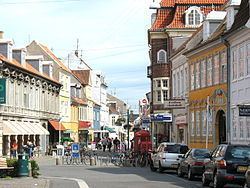Time zone CET (UTC+1) Local time Monday 8:03 AM | Region Zealand (Sjælland) Population 12,665 (2015) | |
 | ||
Weather 6°C, Wind SW at 16 km/h, 97% Humidity Points of interest Danmarks Sukkermuseum, Nakskov Skibs‑ og Søfartsmuseum, Albuen Beach | ||
Nakskov is a town in south Denmark. It is in Lolland municipality in Region Sjælland on the western coast of the island of Lolland. The town has a population of 12,665 (1 January 2015). To the west is Nakskov Fjord, an inlet from the Langeland Belt (Langelandsbælt) that runs between the islands of Lolland and Langeland. Nakskov Fjord is a wildlife reserve, known for its bird life [2].
Contents
- Map of 4900 Nakskov Denmark
- History
- Transport
- Economy
- Nakskov municipality
- Attractions
- Notable people born in Nakskov
- References
Map of 4900 Nakskov, Denmark
History
Nakskov is in the inner part of the Western inlet of Lolland, one of the agriculturally richest of the Danish islands. The area was settled during the neolithic period and has been continuously inhabited since. The town received trade privileges in 1266, during the reign of king Erik V Glipping. Once the export center of western Lolland, Nakskov thrived on trade, commerce and industry. This changed gradually as overland traffic was enabled by a railway to the neighboring island of Falster in 1875,[3]. The connection to Sjælland and Copenhagen over the Storstrømsbroen bridge in 1937 [4] shifted goods from the port of Nakskov. Traditionally a center of manufacturing and industry, Nakskov has turned to commerce and trade, after the industrial boom in shipbuilding ended when Denmark joined the EEC and subsidies were dismantled.
Nakskov is one of the most environmentally conscious and cleanest towns of Denmark. Technological and environmental enterprises replace heavy industries. In recent years, local government has restored the town.
Transport
Nakskov is connected to Nykøbing Falster and the rail network by the Lollandsbanen line.
Boats run from Nakskov to the islands of Nakskov Fjord (Slotø, Vejlø, Enehøje, and Albuen. A ferry connects the Nakskov over the Langeland Belt to Spodsbjerg on the island of Langeland. Bus run within the town and to neighbouring areas. Bike routes follow the dykes encompassing of Lolland.
Economy
Denmark's largest sugar factory is in Nakskov. It processes about 12,000 tons of sugar beet per day and belongs to the German group Nordzucker.
Nakskov municipality
Until January 1, 2007, "Nakskov" was also the name of a municipality (Danish, kommune) covering an area of 33 km², and with a total population of 14,745 (2006). Nowadays Nakskov is integrated into, and encompassed by, Lolland municipality. The last mayor of Nakskov was Flemming Bonne Hansen, a member of the Socialist People's Party (Socialistisk Folkeparti) political party. Nakskov municipality ceased to exist as the result of Kommunalreformen ("The Municipality Reform" of 2007). It was merged with Holeby, Højreby, Maribo, Ravnsborg, Rudbjerg and Rødby municipalities to form the new Lolland municipality. This new municipality consists of an area of 892 km² and a total population of 48,634 (2007).
Attractions
Nakskov Church, dating to the early 13th century, has carved works from the Baroque period including the pulpit (1630) by Jørgen Ringnis and the altarpiece (1656) by Anders Mortensen.
Large parts of the wetlands around Nakskov were drained in the 19th century. The dyke along the southern shore of the fjord allows walking or biking to Langø. The Danish sugar museum (sukkermuseum) is in Nakskov.
